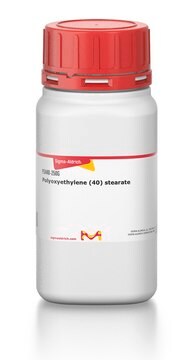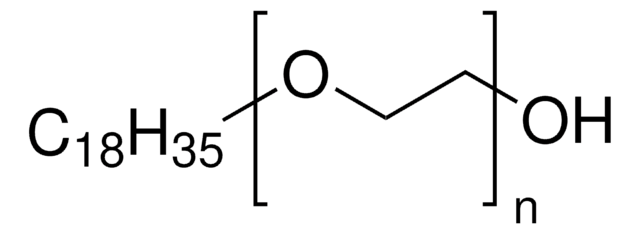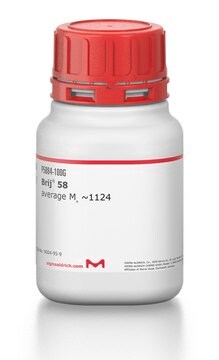466387
Brij® S 100
average Mn ~4,670
Synonym(s):
Polyoxyethylene (100) stearyl ether
Sign Into View Organizational & Contract Pricing
All Photos(3)
About This Item
Linear Formula:
C18H37(OCH2CH2)nOH, n~100
CAS Number:
MDL number:
UNSPSC Code:
12162002
PubChem Substance ID:
NACRES:
NA.23
Recommended Products
mol wt
average Mn ~4,670
mp
51-54 °C (lit.)
hydroxyl value
13‑25 mg KOH/g
solubility
propylene glycol and xylene: insoluble
density
1.1 g/mL at 25 °C (lit.)
HLB
18
InChI
1S/C20H41O2/c1-2-3-4-5-6-7-8-9-10-11-12-13-14-15-16-17-19-22-20-18-21/h2-20H2,1H3
InChI key
PSEGVHKUPXNGGJ-UHFFFAOYSA-N
Looking for similar products? Visit Product Comparison Guide
Related Categories
Application
Brij® S 100 may be used:
- as a non-ionic surfactant to study its interactions with luminol electrochemiluminescence for bioanalysis
- as a carrier material to study the formulation of nimodipine, fenofibrate, and o-vanillin using the particles from gas-saturated solution (PGSS) process
- as a hydrophilic surfactant in the casting solution to prepare an asymmetric flat sheet nanofiltration membranes and to study its effects on the hydrophilic property of the poly(ethersulfone) (PES) nanofiltration membranes
Legal Information
Brij is a registered trademark of Croda International PLC
Signal Word
Warning
Hazard Statements
Precautionary Statements
Hazard Classifications
Acute Tox. 4 Oral
Storage Class Code
11 - Combustible Solids
WGK
WGK 2
Flash Point(F)
Not applicable
Flash Point(C)
Not applicable
Personal Protective Equipment
dust mask type N95 (US), Eyeshields, Gloves
Choose from one of the most recent versions:
Already Own This Product?
Find documentation for the products that you have recently purchased in the Document Library.
Customers Also Viewed
S Rahima Benhabbour et al.
Journal of controlled release : official journal of the Controlled Release Society, 158(1), 63-71 (2011-11-01)
Lipid-based oil-filled nanoparticles (NPs) with a high concentration of surface-chelated nickel (Ni-NPs) were successfully prepared using a Brij 78-NTA-Ni conjugate synthesized with Brij 78 (Polyoxyethylene (20) stearyl ether) and nitrilotriacetic acid (NTA). The facile incorporation of the Brij 78-NTA-Ni conjugate
L Realini et al.
Journal of clinical microbiology, 35(11), 2791-2794 (1997-11-14)
We report on the influences of polyoxyethylene stearate (POES), PANTA, and pH on primary cultures of Mycobacterium genavense in BACTEC vials. As a model for primary cultures from tissue, seven different strains first isolated from AIDS patients (five from Switzerland
S X Liu et al.
Journal of ocular pharmacology and therapeutics : the official journal of the Association for Ocular Pharmacology and Therapeutics, 11(3), 279-282 (1995-01-01)
Although sufficient amount of glucagon can be taken up into systemic circulation through ocular route, the concentration of eyedrops needed at 7.5% would be too high and the price of the doses would be too expensive to be desirable. Attempts
Jigna D Patel et al.
Pharmaceutical research, 24(2), 343-352 (2006-12-21)
The purpose of these studies was to prepare nanoparticles (NPs) with a small amount of surface-chelated nickel for obtaining enhanced binding of histidine-tagged (his-tag) proteins compared to non-histidine-tagged protein binding to charged nanoparticles. NPs were prepared from oil-in-water microemulsion precursors
Tatsuaki Tagami et al.
Journal of controlled release : official journal of the Controlled Release Society, 152(2), 303-309 (2011-02-23)
We have developed a novel and simplified thermosensitive liposomal formulation (HaT: Hyperthermia-activated cytoToxic) composed of DPPC lipid and Brij78 (96:4, molar ratio). The HaT nanoparticles were loaded with doxorubicin (DOX) with >95% efficiency when a pH gradient method and a
Our team of scientists has experience in all areas of research including Life Science, Material Science, Chemical Synthesis, Chromatography, Analytical and many others.
Contact Technical Service









